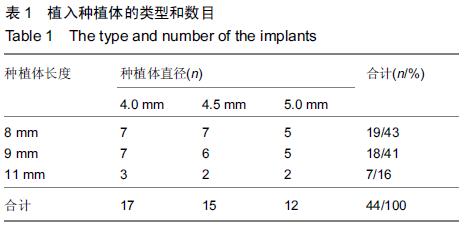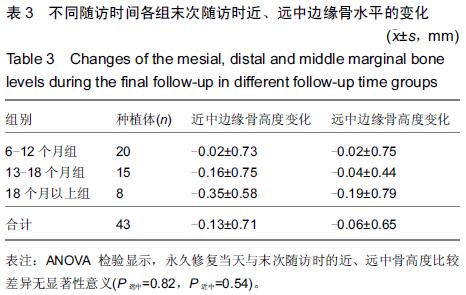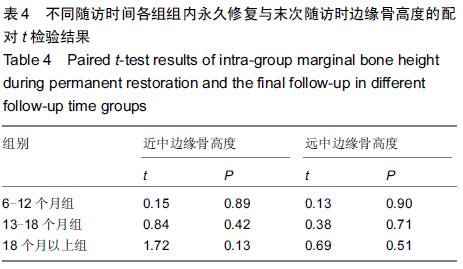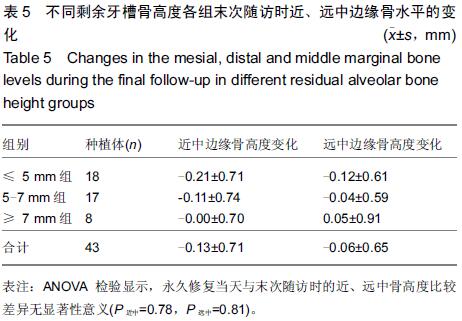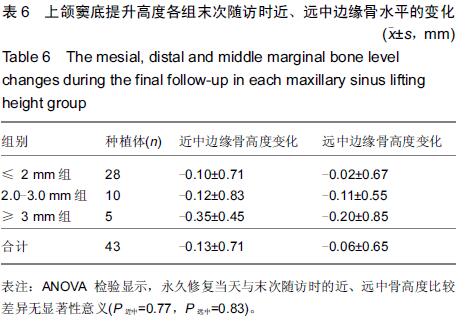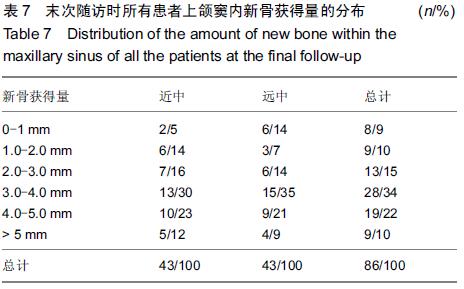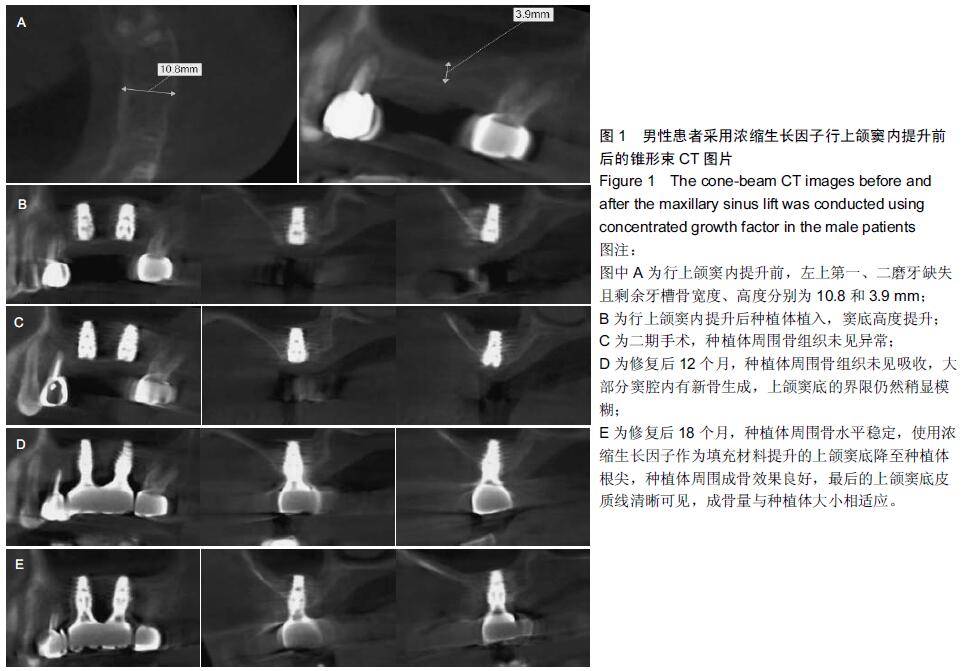| [1] Dohan Ehrenfest DM,Rasmusson L,Albrektsson T. Classification of platelet concentrates: From pure platelet-rich plasma (p-prp) to leucocyte-and platelet-rich fibrin (l-prf). Trends Biotechnol.2009;27(3):158-167.
[2] Cochran DL,Buser D,Ten Bruggenkate CM,et al.The use of reduced healing times on iti® implants with a sandblasted and acid-etched (sla) surface. Clin Oral Implants Res.2002;13(2): 144-153.
[3] Lindh C,Petersson A,Rohlin M.Assessment of the trabecular pattern before endosseous implant treatment: Diagnostic outcome of periapical radiography in the mandible. Oral Surg Oral Med Oral Pathol Oral Radiol Endod.1996;82(3):335-343.
[4] Summers RB.The osteotome technique: Part 3--less invasive methods of elevating the sinus floor. Compendium. 1994; 15(6):698, 700.
[5] Nedir R,Bischof M,Vazquez L,et al.Osteotome sinus floor elevation without grafting material: A 1‐year prospective pilot study with iti implants.Clin Oral Implants Res. 2006; 17(6): 679-686.
[6] Rosen PS,Summers R,Mellado JR,et al.The bone-added osteotome sinus floor elevation technique : Multicenter retrospective report of consecutively treated patients. Int J Oral Maxillofac Implants.1999;14(6):853-858.
[7] 符志锋,郭庆平,繆颖.上颌窦内外提升不植骨替代材料同期种植牙:随访周围骨量及稳定性的变化[J].中国组织工程研究,2015, 19(3): 394-398.
[8] Palma VC,Magro-Filho O,de Oliveria JA,et al.Bone reformation and implant integration following maxillary sinus membrane elevation: An experimental study in primates.Clin Implant Dent Relat Res.2006;8(1):11-24.
[9] Lundgren S,Anderson S,Gualini F,et al.Bone reformation with sinus membrane elevation: A new surgical technique for maxillary sinus floor augmentation.Clin Implant Dent Relat Res.2004;6(3):165-173.
[10] Hatano N, Sennerby L, Lundgren S. Maxillary sinus augmentation using sinus membrane elevation and peripheral venous blood for implant‐supported rehabilitation of the atrophic posterior maxilla: Case series.Clin Implant Dent Relat Res.2007;9(3): 150-155.
[11] Sohn DS,Kim WS,An KM,et al.Comparative histomorphometric analysis of maxillary sinus augmentation with and without bone grafting in rabbit.Implant Dent.2010;19(3): 259-270.
[12] Esposito M,Grusovin MG,Rees J,et al.Effectiveness of sinus lift procedures for dental implant rehabilitation: A cochrane systematic.Eur J Oral Implantol.2010; 3(1): 7-26.
[13] Si MS,Mo JJ,Zhuang LF,et al.Osteotome sinus floor elevation with and without grafting: An animal study in labrador dogs.Clin Oral Implants Res.2013;26(2):197-203.
[14] Rodella LF,Favero G,Boninsegna R,et al.Growth factors, cd34 positive cells, and fibrin network analysis in concentrated growth factors fraction. Microsc Res Tech.2011; 74(8):772-777.
[15] 柳宏志,邹高峰,王天祥,等.浓缩生长因子促进犬软组织损伤修复的实验研究[J].口腔颌面外科杂志,2013,23(1):28-31.
[16] Dohan DM.Platelet-rich fibrin (prf): A second-generation platelet concentrate. Part i: Technological concepts and evolution.Oral Surg Oral Med Oral Pathol Oral Radiol Endod. 2006;101(3):e37-44.
[17] Choukroun J,Diss A,Simonpieri A,et al.Platelet-rich fibrin (prf): A second-generation platelet concentrate. Part iv: Clinical effects on tissue healing. Oral Surg Oral Med Oral Pathol Oral Radiol Endod.2006;101(3):e56-e60.
[18] Kim TH,Kim SH,Sándor GK,et al.Comparison of platelet-rich plasma (prp), platelet-rich fibrin (prf), and concentrated growth factor (cgf) in rabbit-skull defect healing.Arch Oral Biol.2014;59(5):550-558.
[19] Choukroun J. Platelet-rich fibrin (prf): A second-generation platelet concentrate. Part v: Histologic evaluations of prf effects on bone allograft maturation in sinus lift.Oral Surg Oral Med Oral Pathol Oral Radiol Endod.2006;101(3):299-303.
[20] Sohn DS.Bone regeneration in the maxillary sinus using an autologous fibrin-rich block with concentrated growth factors alone.Implant Dent.2011;20(5):389-395.
[21] Kim JM.Minimally invasive sinus augmentation using ultrasonic piezoelectric vibration and hydraulic pressure: A multicenter retrospective study. Implant Dent. 2012; 21(6):536-542.
[22] Tan WC,Lang NP,Zwahlen M,et al.A systematic review of the success of sinus floor elevation and survival of implants inserted in combination with sinus floor elevation. Part ii: Transalveolar technique.J Clin Periodontol.2008;35(8 Suppl):241-254.
[23] Reiser GM,Rabinovitz Z,Bruno J,et al.Evaluation of maxillary sinus membrane response following elevation with the crestal osteotome technique in human cadavers. Int J Oral Maxillofac Implants.2001;16(6):833-840.
[24] Nkenke E,Schlegel A,Schultze-Mosgau S,et al.The endoscopically controlled osteotome sinus floor elevation: A preliminary prospective study.Int J Oral Maxillofac Implants. 2001; 17(4):557-566.
[25] Nkenke E,Schlegel A,Schultze-Mosgau S,et al.The endoscopically controlled osteotome sinus floor elevation: A preliminary prospective study.Int J Oral Maxillofac Implants. 2002;17(4):557-566.
[26] Doud Galli SK,Lebowitz RA,Giacchi RJ,et al.Chronic sinusitis complicating sinus lift surgery.Am J Rhinol.2001;15(3):181-186.
[27] Cavicchia F,Bravi F,Petrelli G.Localized augmentation of the maxillary sinus floor through a coronal approach for the placement of implants.Clin Implant Dent Relat Res. 2001;21(5): 475-485.
[28] Abrahamsson I,Berglundh T.Tissue characteristics at microthreaded implants: An experimental study in dogs.Clin Implant Dent Relat Res.2006;8(3):107-113.
[29] Diss A,Dohan DM,Mouhyi J,et al.Osteotome sinus floor elevation using choukroun's platelet-rich fibrin as grafting material: A 1-year prospective pilot study with microthreaded implants.Oral Surg Oral Med Oral Pathol Oral Radiol Endod. 2008; 105(5):572–579.
[30] Toffler M.Osteotome-mediated sinus floor elevation using only platelet-rich fibrin: An early report on 110 patients.Implant Dent.2010;19(5):447-456.
[31] Kanayama T,Sigetomi T,Sato H,et al.Crestal approach sinus floor elevation in atrophic posterior maxilla using only platelet rich fibrin as grafting material: A computed tomography evaluation of 2 cases. J Oral MaxillofacSurgery Med Pathol.2013.
[32] Choukroun J.Platelet-rich fibrin (prf): A second-generation platelet concentrate. Part iv: Clinical effects on tissue healing. Oral Surg Oral Med Oral Pathol Oral Radiol Endod.2006; 101(3):e56-e60.
[33] Sohn DS,Heo JU,Kwak DH,et al.Bone regeneration in the maxillary sinus using an autologous fibrin-rich block with concentrated growth factors alone.Implant Dent.2011;20(5):389-395.
[34] Tajima N.Evaluation of sinus floor augmentation with simultaneous implant placement using platelet-rich fibrin as sole grafting material.Int J Oral Maxillofac Implants. 2013; 28(1):77-83.
[35] Simonpieri A,Choukroun J,Del CM,et al.Simultaneous sinus-lift and implantation using microthreaded implants and leukocyte- and platelet-rich fibrin as sole grafting material: A six-year experience.Implant Dent.2011;20(1):2-12.
[36] Toffler M.Osteotome-mediated sinus floor elevation: A clinical report. Int J Oral Maxillofac Implants.2004;19(2):266-273. |
